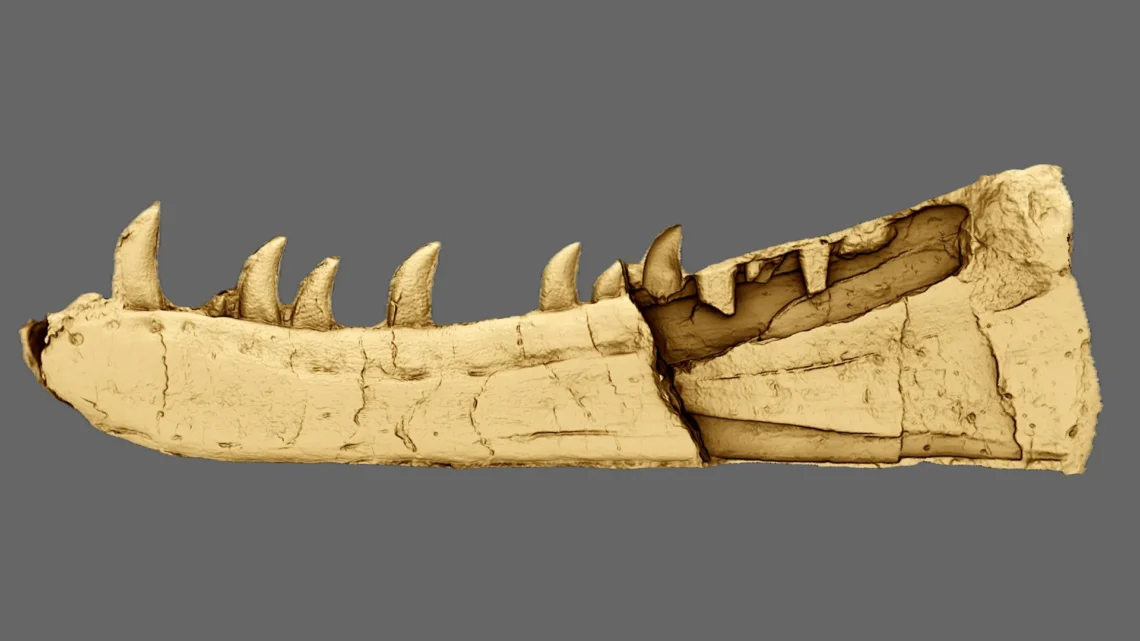Paleontologists at the University of Bristol have confidently identified a new species of dinosaur from Triassic fossils found in South Wales, close to Penarth—over 125 years after the specimen was first noted.
Thanks to modern digital scanning techniques, the researchers have gained fresh insights into a fossil jawbone that has been known since 1899 and displayed at the National Museum of Wales for many years, but was misidentified until now.
This fossil takes the form of natural molds of the jawbone in rock, with the original bone completely eroded away. Paleontology student Owain Evans utilized photo scanning technology to create a precise 3D digital model, allowing for detailed analysis.
Owain Evans explained, “This specimen has been referenced numerous times in scientific literature, yet its identity remained unclear—there was even doubt about whether it was a dinosaur. Originally named Zanclodon cambrensis by Edwin Tully Newton in 1899, we found that the name Zanclodon had been made obsolete, as it encompassed a wide range of early reptiles. So, we decided to honor Newton by naming it Newtonsaurus, as it stands apart from other dinosaurs of that era and deserves a unique name.”
Professor Michael J Benton, the lead author of the study, remarked, “The natural molds of the jawbone capture astonishing detail—showing grooves, ridges, teeth, and even the serrations along the edges. Using digital photography, we created a 3D model by scanning the fossil with photogrammetry. After that, we inverted the scan, creating a digital negative of the mold. By merging both sides, we could closely analyze the anatomy. The digital reconstruction provides a clearer picture of what the original bone structure would have looked like.”
With the fossil now thoroughly examined, the researchers were able to determine its place in the reptile family tree, particularly whether it belonged to the dinosaur group.
Owain Evans confirmed, “We can now assert that this specimen most likely belonged to a large predatory theropod dinosaur that roamed the shorelines of South Wales during the late Triassic period. It exhibits clear dinosaur characteristics in how the teeth are placed, identifying it as a theropod—a carnivorous, flesh-eating dinosaur. Additionally, it seems to be close to the origins of the two major divisions of Theropoda: the Coelophysoidea and the Averostra.”
“What surprised us most was the size of the creature. The jawbone we preserved measures 28 cm in length, which is just the front half; originally, it would have measured 60 cm, indicating a dinosaur with a body length between 5 and 7 meters. That’s unusually large for a Triassic theropod, most of which were usually smaller.”
Cindy Howells from the National Museum of Wales stated, “These historical specimens hold immense value in paleontology, often revealing new and exciting findings—even after lying in collections for years. The Victorians were fascinated by fossil records, exploring the UK extensively for them. Furthermore, the re-description of Newtonsaurus cambrensis again sheds light on Wales’ importance in paleontological studies. These Triassic beds are rare globally, yet Wales has several. There may still be undiscovered dinosaurs waiting here.”
Summary: Researchers at the University of Bristol have confirmed a new dinosaur species named Newtonsaurus, discovered from a fossil jawbone dated back to the Triassic period in South Wales. Using advanced scanning techniques, the team revealed that this predatory theropod dinosaur was significantly larger than most of its contemporaries. The findings underscore the importance of historical specimens in paleontological research, particularly within the unique geological landscape of Wales.





